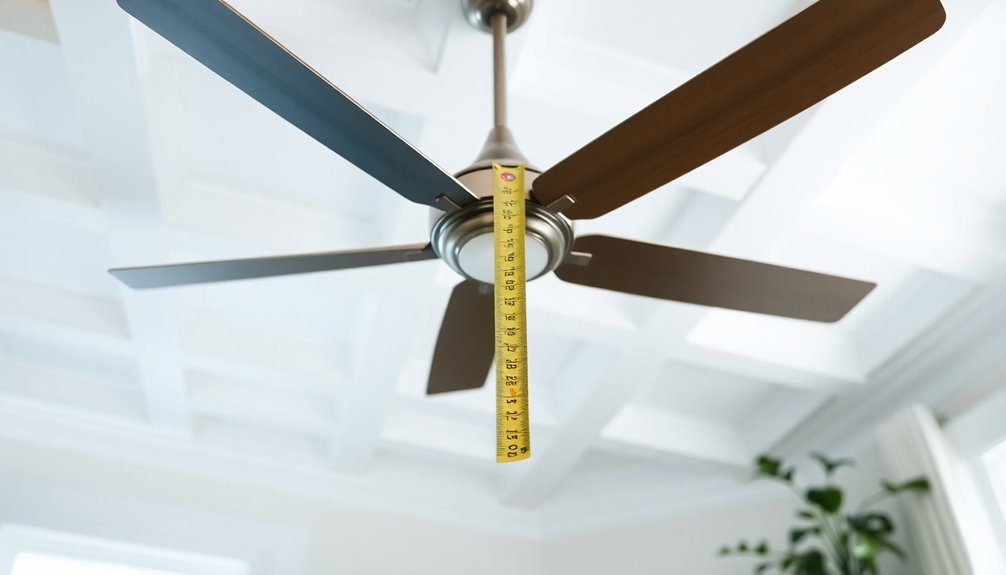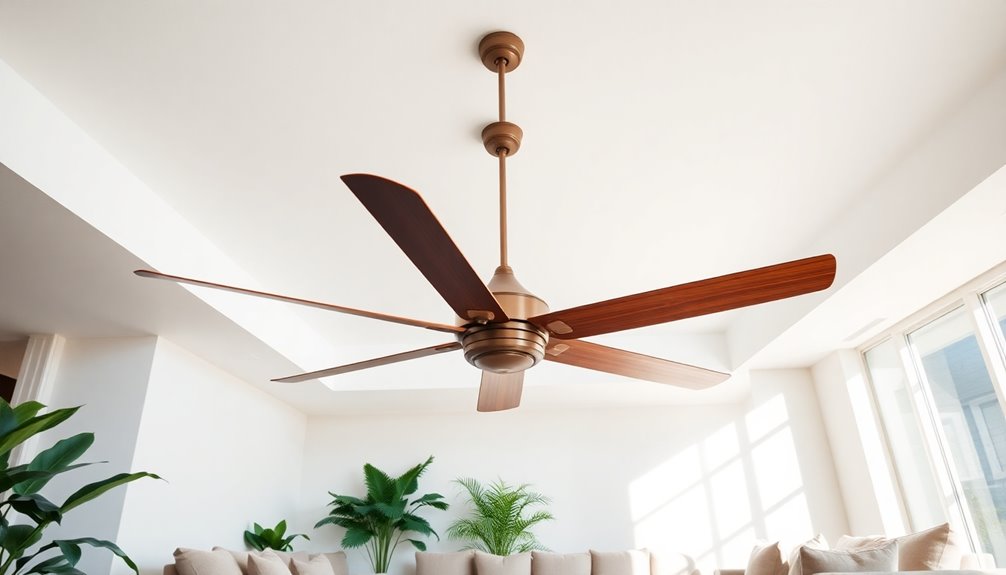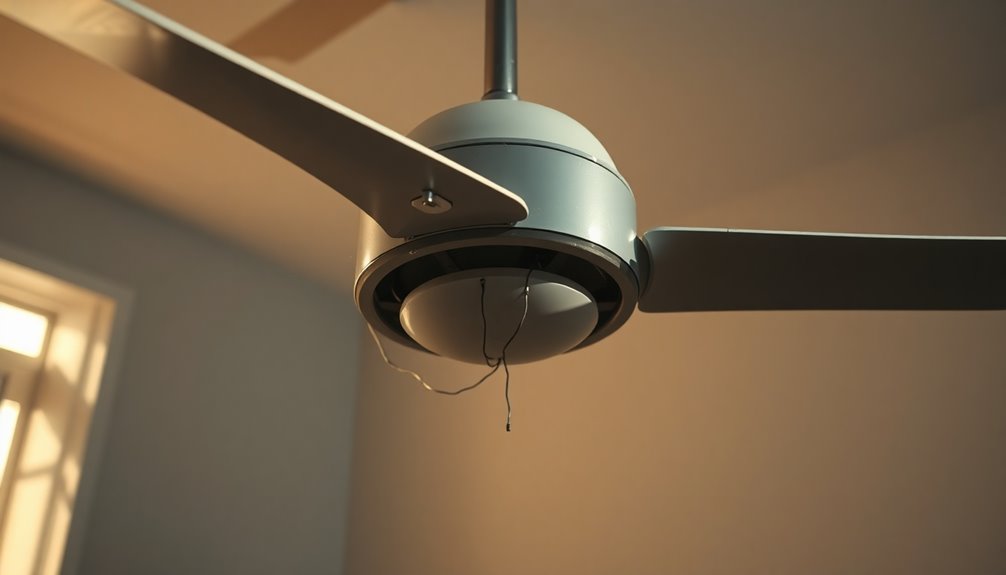To measure ceiling fan size, start by checking your room dimensions. Measure the length and width, then calculate the square footage. Next, focus on the fan span, which is the diameter from one blade tip to the opposite. If your fan has an odd number of blades, measure from a blade tip to the center and double it. Finally, assess your ceiling height for proper clearance. Maintaining at least 8 inches above the ceiling and making certain blades sit 7 feet above the floor is essential. Discover more tips to guarantee your fan is the right fit for your space.
Key Takeaways
- Ceiling fan size is measured by the span, which is the diameter of the circle formed by the tips of the blades.
- For even-blade fans, measure from tip to opposite tip; for odd-blade fans, measure from a blade tip to the center and double it.
- Proper span measurement ensures compatibility with room dimensions and optimal air circulation.
- Maintain a clearance of at least 8 inches from the ceiling for fan blades and 7 feet above the floor for safety.
- Consider the ceiling height and any light kits that may affect the overall height of the fan installation.
Measuring Room Dimensions

When you're ready to measure your room dimensions, grab a tape measure and get started. First, measure the length of the room by stretching the tape from one wall to the opposite wall.
Next, measure the width by positioning the tape perpendicular to the length. With these measurements, you can calculate the square footage by multiplying the length by the width. For instance, if your room is 12 feet long and 15 feet wide, the total area would be 180 square feet.
If you're dealing with an L-shaped room, break it down into two rectangles. Measure each section, calculate the square footage separately, and then sum those areas for the total square footage.
Don't forget to measure the ceiling height as well. This measurement is vital for determining the best placement of your ceiling fan.
You may also need to take into account a downrod to guarantee ideal airflow, especially in rooms with higher ceilings. By accurately measuring your room size, you'll be better equipped to choose the right ceiling fan size for your space.
Measuring Ceiling Fan Span

How do you measure the ceiling fan span accurately? To determine the ceiling fan span, also known as the blade span, you need to measure the diameter of the circle created by the tips of the fan blades when the fan is in motion.
For even-blade ceiling fans, use a tape measure to measure straight from the tip of one blade to the tip of the blade directly opposite. If you have an odd-blade ceiling fan, measure from the tip of one blade to the center of the fan, then double that measurement to find the full diameter.
Getting this measurement right is essential for ensuring compatibility with your room size and achieving ideal air circulation.
Determining Ceiling Fan Height

After measuring the ceiling fan span, the next step is determining the proper height for your ceiling fan installation.
Start by measuring the ceiling height accurately, taking into account any light kits or fixtures that might add to the fan's overall height. For ideal air circulation, fan blades should be positioned at least 8 inches from the ceiling. Additionally, the recommended height for fan blades is no less than 7 feet above the floor to avoid head impact.
If you're installing a ceiling fan in a room with ceilings under 8 feet high, consider using a low-profile ceiling fan. These hugger fans maximize headroom and guarantee safety.
For ceilings higher than 9 feet, you'll need to use downrods to lower the fan. The best height for fan blades in this case is between 8 to 9 feet from the floor, which allows for both clearance and effective airflow.
Remember to measure the distance from the floor to the fan blades, confirming that you achieve the ideal height for comfort and performance.
Taking these factors into account will help you enjoy the benefits of your ceiling fan without any safety concerns.
Calculating Downrod Length

To achieve the ideal height for your ceiling fan, calculating the downrod length is vital. Start by measuring your ceiling height and subtracting the combined height of the fan housing and mounting bracket. This will give you the initial downrod length required. For maximum airflow, confirm the fan blades are positioned 8 to 9 feet above the floor.
Here are some key points to remember:
- Ceiling height: Accurate measurement is important for proper installation.
- Obstacles: Consider cabinets or light fixtures that might affect clearance.
- Fan housing height: Typically ranges from 8 to 12 inches, so factor this into your calculations.
For example, if your ceiling height is 10 feet, a 12-inch downrod may be necessary to position the fan at the recommended height of 8 feet.
Always double-check your measurements to verify you've accounted for all elements, including any obstacles. This way, you'll create a comfortable environment with effective airflow while maintaining safety during installation.
Properly calculated downrod length not only enhances functionality but also adds to the aesthetic appeal of your space.
Additional Considerations for Fans

When selecting a ceiling fan, keep several important factors in mind to guarantee peak performance and safety.
First, make certain the fan size fits your room's dimensions; the blades should be at least 30 inches away from walls or obstructions to promote optimal airflow. If your ceiling has a slope greater than 32 degrees, you'll need a slope mount fan for proper installation and functionality.
Consider the weight of the ceiling fan as well. It's vital to mount it on a structure that can support its weight to avoid any safety hazards.
If your fan includes integrated lighting, remember to account for the additional height required for safe clearance above the fan blades.
Finally, assess the overall layout of the room. The placement of the fan is key to circulating air effectively throughout the space.
Frequently Asked Questions
How Is a 52 Inch Ceiling Fan Measured?
To measure a 52-inch ceiling fan, you start by ensuring the fan's off.
Grab a tape measure and find the distance from one blade tip to the opposite blade tip.
If your fan has an odd number of blades, measure from one blade tip to the motor's center and double that measurement.
Remember to keep at least 30 inches of clearance from the blades to the nearest wall for ideal airflow.
Is a 52 Inch Fan Too Big for a 12X12 Room?
They say, "Everything in moderation."
A 52-inch fan might be too big for your 12×12 room. Ideally, you'd want a fan with a blade span of 36 to 44 inches for ideal airflow. A larger fan could create excessive airflow, making the room uncomfortable.
If you still choose the 52-inch option, make certain it's centered and has at least 30 inches of clearance from walls to maintain proper airflow and aesthetics.
What Is the Meaning of a 1200 Mm Ceiling Fan?
A 1200 mm ceiling fan means it has a blade span of 1200 millimeters, which is about 47.2 inches.
This size is perfect for medium-sized rooms, typically between 144 to 225 square feet. It delivers good airflow and cooling efficiency without overpowering the space.
How to Measure a Ceiling Fan With an Odd Number of Blades?
You might think measuring a ceiling fan sounds tricky, but it's actually pretty straightforward!
First, turn off the fan and make sure it's completely stopped. Grab a tape measure and measure from the tip of one blade to the center of the motor to find the radius.
Double that measurement to get the full blade span. Just remember to measure at the widest point for accuracy—this'll give you the right size you need!
Conclusion
In the dance of air and light, choosing the right ceiling fan is like selecting the perfect partner for your room. Each measurement you take—the span, height, and downrod length—harmonizes to create a symphony of comfort and style. Just as every space has its own rhythm, finding the right fan elevates your environment, turning a simple room into a sanctuary. Embrace the art of balance, and let your ceiling fan become the gentle breeze that breathes life into your home.









